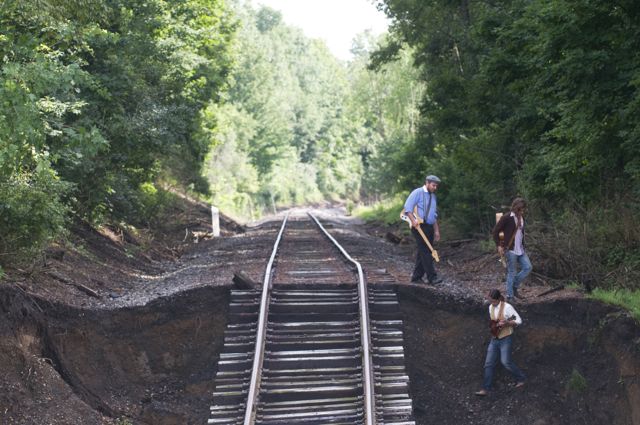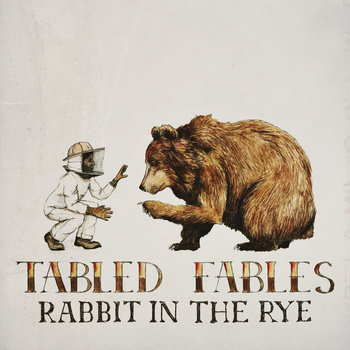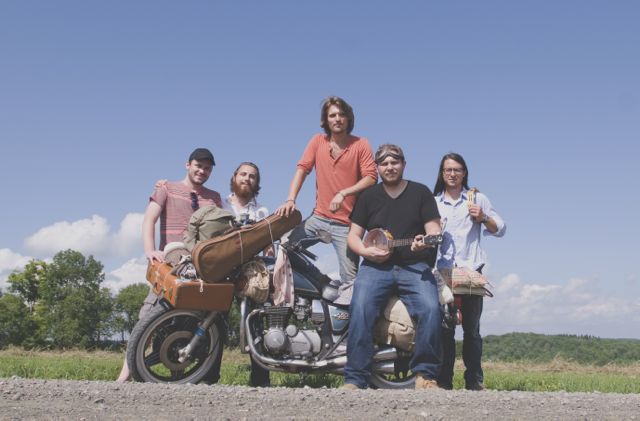Folk-rock trio Rabbit in the Rye (Joseph Mettler on guitar and harmonica, Alexander Lavon on bass, Brendan O’Connor on percussion and mandolin) is based in upstate New York — a region that informs both the band’s sound and the sense of community. But what plays the biggest role in Rabbit in the Rye’s aesthetic is a commitment to storytelling, as Mettler explains, below.
“Well here, in the hayfield with a blanket in tow. I tuck the fire in ‘til the breathing is slow,” the band sings on “Oh Brother, I Love You.” It’s a dreamy song that skips and floats like sparks against a velvety night sky. Songs can be that. The imprint of memories. Wooden canoes painted red and blue and set to drift on rivers named for long-vanished Indian tribes. Apple orchards and small vineyards tidy in squares of green and black earth, a patchwork quilt stitched by long roads where a car can drive for miles without passing another car. Maybe a tractor. Maybe an Amish wagon.
“Rapturous Rays,” with its bite and the kick of its drums, the one-two punch of vocals that beat at the loneliness of space and the frailty of dreams, captures so well the upstate N.Y. malaise. The prettiness of its gorges and pebble beaches; the bleakness of its small towns and quick-advancing winters. “I’d like to stay in the sun,” the songs says. Beseeches. Twists in agony and energy into a psychedelic jam of sorts. Honey hives and blackberry brambles. The plenty of summer just a foil for the long cold season always encroaching.
Currently on tour, the trio makes its first-ever Asheville stop at Isis on Saturday, Aug. 17. 9 p.m. $8 advance/$10 at the door.

Mountain Xpress: From your bio to the title of your debut album, there’s the sense that you’re invested in song as a vehicle for telling a story. What is the narrative of Tabled Fables? And are there any actual fables from which you draw inspiration?
Joseph Mettler: We see storytelling as tradition, and an integral part of the lives of everyone everywhere. It gathers people. From the womb to the tomb, from children’s bedtime stories to grim and gruesome ghost stories and grandpa’s boastful fishing feats, stories have been around for a long time, and music is our way of telling our own. In that way, we are subject to similar stories that all people are subject to. They are inescapable. We identify heavily with early folk songwriters and, consciously or not, tend to stray away from nowadays’ conventionally-structured means of expressing an abstract feeling or fleeting fancy.
In the formative months of our beginnings as a band, under the same roof and next door to the town airport, writing quickly found a nook in our personal lives. Wagering short stories for the winner of a game of darts, listening to old folk tales and reading passages out loud as the airplanes landed and were put away in their hangers. I think it’s safe to say that our influences so far have most importantly included writers. The band name is a conglomeration of J. D. Salinger and John Updike novels. The album is a result of years of not only hardship, but also of the retreat into Aesop’s Fables, Lewis Carroll and endless early myths and folklores.
The music itself often follows the craft, plucking away at our instruments until we are reminded of a contiguous thought – often an analogy based on some remembered happening. As the three of us come from differing musical backgrounds, the music aesthetic is ever-changing while maintaining that general sense of romanticism about it. I might add that it tends to get away from us, resulting in longer songs like “The Bear & the Beekeeper Blues” or “Rapturous Rays.” I think it’s important to let that happen despite endless advice about radio time and ensuring that the listener is fully attentive throughout the entire song. If there is a story to be told, then we figure that we might as well tell the whole thing.

Your song, “Rapturous Rays” really reminds me of summer days driving country roads around the Finger Lakes. Do you feel like the upstate New York landscape finds its way into your compositions or songwriting? Absolutely. Living in the countryside is at the root of our roots as a band, and often finds its way into our songwriting. There is no bigger space for the imagination to run rampant, and as far as support goes, we couldn’t hope for a stronger sense of community. Having grown up playing hide and seek in the tall corn, damming creek beds with the biggest rocks a boy can budge, and now with the three of us working through the days, the landscape has remained at the heart of it all.
I work as a carpenter and lumberjack, Brendan as an organic vegetable farmer and Alex for the newest pride and joy of the town, Good Nature Brewing Co., using local New York ingredients to craft the best beers around (who, since their start at the beginning of 2012, have also released a beer in our name, Rabbit in the RyePA). Just now we are touring the country with our newest collection of songs on our “Grain, Gold & Gravel” tour, in itself a reference to our home, our families and our upbringings.
I love the profile photo of the band on the motorcycle. What’s the story with that shot, and how many tries did it take for you to get it? It took enough tries so that the motorcycle overheated and the head gasket started pouring oil. It was pretty comical, actually. Our good friend and photographer (Jimi Button Photography) sat on the roof of our good friend and sound engineer’s moving car (Jeremy Johnston of Subcat Studios) as we drove through the countryside. That, in combination with driving a motorcycle a couple hundred pounds over capacity, was pretty exhilarating. We very quickly found out that the motorcycle had to be in motion both when Brendan got on and jumped off, otherwise that extra weight made driving pretty unpredictable. Needless to say, there was a lot of sighing and head shaking from the front porches of older folks around town. Despite the obvious exaggeration involved, I think it pretty accurately depicts the feeling of our tearing across the land as a band.
Tell us a bit about your live show — how does it differ from the sound of your album, and do you fill out your set list with any covers? If you do play the occasional cover, what are some favorites? Of course, there is hardly [as much] lip biting, foot stomping and teeth grinding in the studio versions of our songs as in the live versions. There is something so unpredictable and essential to playing in a collective space, and to an audience. As storytellers, it helps to have an audience to tell the story to. That played a major part in our decision to start this “Grain, Gold & Gravel” project. Not only are we touring our new material, but we are also releasing a live video series with six select songs in different locations around our home — in the bed of a moving truck, inside an abandoned watertower, atop the stage of the ever growing Earlville Opera House, and more. We’re hoping that it will give a good look into the place where we live, as well as our faces and the performance aspect of our music that doesn’t fully come through in a studio release.
As far as covers go, we tend to play entirely original material, unless some sort of request is made, or until we have exhausted the hours of music that we call our own. In the past we have covered singer-songwriter material such as Josh Ritter, Ray LaMontagne or Bob Dylan to bar crowd favorites like Smokey Robinson or Gnarls Barkley.
You mentioned that your Aug. 17 show at the Isis will be your first in Asheville. What have been some of your favorite tour stops so far — any towns or venues that have surprised you? Our favorite shows on the tour so far would have to be on the two opening nights. The first was a sold out show at Lyric Hall in New Haven, Conn. with the up-and-coming band Kindred Queer. It’s always nice to discover little pockets of people around the country with a similar interest as you, and the sense of community there was staggering. The venue itself is an old, renovated opera house and the audience was so attentive that both bands were able to sing without microphones for a large majority of show. It was a great introduction into a city in which we had never played before.
The second show was at The Bowery Electric in Manhattan. We have frequented New York City since we started to play outside of our hometown in late December of last year, and it was nice to see some familiar faces — of which there are becoming more and more these days — and to have the audience dancing and shouting encore requests. Not only that, but we had the pleasure of splitting the bill with our good friend Adrian Blake Enscoe, now under the moniker Gene Jacket, also from Hamilton, NY. Adrian is co-owner of In the Basement Theater Co., a company that has commissioned us to score a theater piece by the name of The Lady in Red Converses with Diablo. The show is set to start in late October, and we are excited to announce that we will be moving to Brooklyn for several months to be a large part of that process.
All venues aside, we have been met with generous hospitality everywhere that we have gone, and haven’t had to pitch our tent even once yet. Lastly, there’s just something about being out here on the road that is so unbelievably terrifying and liberating. Every town is a surprise. You just never know when your car is going to break down, or if you’ll be eating a hot meal that night, or what extra passengers you’ll pick up along the way, and that’s one of the best feelings of all. Uncomfortable freedom.




Question # 6-
Why does NY wimp folk music invade WNC for all its
stout trad music?
Does “Wagon Wheel” really mean that much to you?
Hint- listen to the lyrics again- the geography is
off.